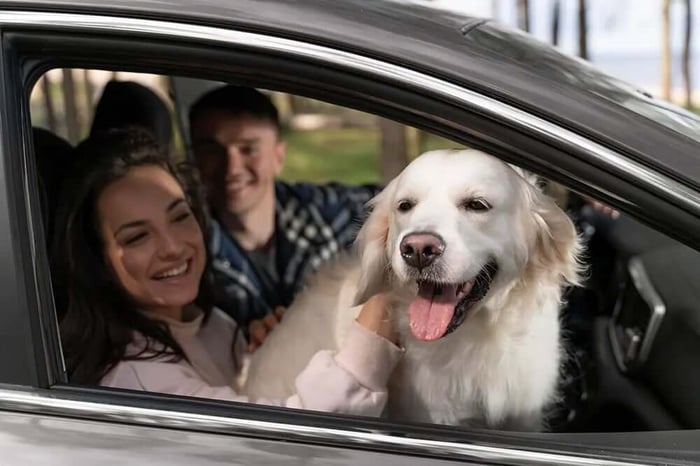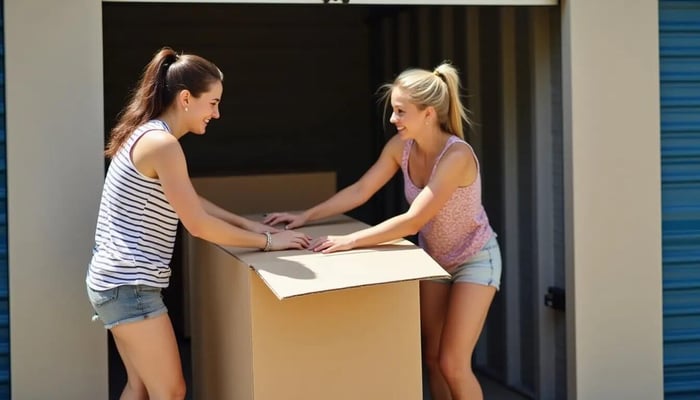Table of Contents
- Tip 1: Visit the Vet
- Tip 2: Find a New Vet
- Tip 3: Maintain a Routine
- Tip 4: Get a Pet Travel Carrier
- Tip 5: Pack a Pet Essentials Bag
- Tip 6: Create a Move Day Schedule
- Tip 7: Pet-Proof Your New Home
- Tip 8: Introduce Them Slowly
- Tip 9: Quickly Re-Establish Their Routine
- Tip 10: Use Calming Aids
- Tip 11: Use a Pet Sitter or Boarding Service
- A Little Planning Goes a Long Way...
- You're Done Moving with Pets! Next Up: Self-Storage for Pet Gear
- FAQs
Moving is stressful for (almost) everyone - and that includes your pets! It’s essential to plan ahead when moving with pets so that your furry friends feel comfortable and stress-free, whether you’re relocating locally or across the country.
Animals are considered creatures of habit. When their surroundings suddenly change, they’re likely to experience stress and anxiety. When you pre-plan your move, you can slowly acclimate to it. This will help reduce the likelihood of stress-related behaviors, including hiding, excessive barking, accidents, and timidity.
When you plan ahead for a move with pets, you’ll also ensure their safety, minimize any logistical challenges for yourself, and have a smoother transition into your new space. Plus, you’ll make the moving process more efficient!
In our guide, you’ll learn practical and compassionate ways to ensure your furry family member is well-prepared for their move, from moving day to settling into their new environment.
Tip 1: Visit the Vet
Schedule a last-minute vet visit before moving with pets to ensure your pet is up to date with vaccinations and any necessary medications. Also, prepare ahead for any medications your pet may need for its new home. If your pet is prone to anxiety, you can also discuss calming medications with your veterinarian.
Insider Tip: Research the environment of your new location and how it could impact pets! When I moved across state, my new town and city had a large tick population - something I discovered via Google. I brought this up to my vet, and they suggested I ensure my dog had his Lyme vaccine and was on a flea & tick preventative (ask your vet for recommendations, but my dogs have done well with Nexgard).
At your appointment, ask for a copy of your pet’s health records - and have them emailed to you, if possible. Old, hardcopy records may get lost in the shuffle during the move! Lastly, if your pet has a microchip, update the contact information to your new address.
Tip 2: Find a New Vet
Before moving, pet owners should also research veterinarian offices in their new location. Check out Google reviews and sites like PetHelpFinder.org for patient insights.
When selecting a new veterinarian, have your current provider transfer your health records. If possible, schedule an appointment with the new vet’s office to establish care.
Tip 3: Maintain a Routine
Before you move with pets, stick to their regular schedule. Ensure that feedings, playtime, walks, and other daily activities are scheduled at the same time every day. Even on the day of your move, try to plan their meals and walks at the same time you would regularly (if possible).
Tip 4: Get a Pet Travel Carrier
A pet travel carrier is advantageous and necessary when you're moving with pets - whether you’re traveling by car, plane, or even train (yes, I’ve used a pet carrier numerous times on Amtrak!).
When you’re choosing a pet carrier, you’ll want to consider:
Size: Roomy enough for your pet to move around in, but not too large that it’s heavy and cannot fit. Also, if you’re flying, check the airline’s size requirements.
Construction & Materials: Opt for durable materials and zippers that are hard for a pet to open accidentally.
Ventilation: Mesh panels or ventilation holes are a must, even for small pets like hamsters.
Comfort: Think soft lining and padding, as well as room for a little blanket and plush toy
Weight: Even though you want something strong and durable, a lightweight option is the way to go - especially for longer distances
The ability to connect the carrier to a seatbelt or attach the carrier to the back seat
Invest in a high-quality pet carrier. You’ll be able to use it in the future, even if you don’t plan on moving again! They’re great for transporting your pet to the vet, puppy playdates, and road trips.
Insider Tip: I loved using this SHERPA Element Dog & Cat Carrier when moving dogs across state (4.5-5 hour drive). It was lightweight, easy to clean, and very affordable. I chose it over others because of the weight, durable materials, and mesh panels around a majority of the exterior. Even though I don’t plan on moving again, this carrier has been great to use in the car!
Tip 5: Pack a Pet Essentials Bag
You packed an essential bag for yourself, but when moving with pets, you should pack one for your pet, too! In your essentials bag, pack things your pet will need immediately, including:
Food and treats, as well as a water bowl
Daily medications
Collar with ID tags and harness or leash
Litter box and litter, puppy potty pads, and waste bag
Favorite toys
Blanket or pillow to temporarily sleep on (if the pet bed had to be packed)
For traveling with a pet that lives in a crate or tank, most essentials you need will already be coming along with you. However, make sure to have food and other everyday necessities.
Tip 6: Create a Move Day Schedule
Keep your pets safe, calm, and comfortable on move-in day! They’ll need to get accustomed to their new surroundings. A few things to add to your “Pet Move-In Day Schedule” include:
Morning of the Move
Feed your pet early to reduce the risk of nausea or car sickness
Potty break with a long walk or playtime to ease anxiety
Secure a quiet, safe pet area, away from movers or moving boxes
Tasks During Transport
Set up their carrier and secure it in the transportation method. You can never pack your pet in the moving truck
Schedule frequent stops for water and potty breaks
Upon Arrival at Your New Place
Secure a new quiet, pet-friendly area that’s away from movers and has familiar items to help your pet relax and decompress
Set up a water bowl and offer a small amount of food
Stick to your normal feeding and walking schedule
Frequently check in to make sure your pet is OK
Tip 7: Pet-Proof Your New Home
Once you’ve arrived at your new home and have settled in, it’s time to pet-proof your place. There are many different tips to pet-proofing your home, but a few general tips include:
Secure any loose wires or cords
Store cleaning supplies and personal care products in cabinets & use childproof latches if necessary
Cover trash cans
Secure windows and screens, especially for sliding doors
Use baby gates where necessary to block pets from areas they shouldn’t be (for small dogs, I love these ETNA Wood Heart Shape Gates from Chewy and have three myself - they’re easy to move and look cute)
Close your toilet lids
Block any gaps under your fence or fence gate, and secure the gate latch
The American Humane Society offers a concise yet comprehensive guide on how to pet-proof various areas of your home, including the living room, kitchen, and garage.
Tip 8: Introduce Them Slowly
As you settle into your new house, it’s important to slowly introduce your pet to the space to avoid overwhelming them - especially if it’s their first time moving.
Designate one quiet, enclosed area where they can feel safe
Stock the space with their favorite items they’re familiar with: a bed, blanket, toys, and a water bowl
Allow them to explore one room at a time at their own pace
Keep interactions calm and positive
Use positive reinforcement as they explore their new area
Tip 9: Quickly Re-Establish Their Routine
Pets thrive on consistency, so you want to reestablish their routine as quickly as possible after the move. Aim to feed, walk, and play with your pets at the same time each day. Don’t veer from their usual schedule.
Familiar patterns will help provide a sense of security and predictability. While it may be difficult to factor in your pet’s schedule when unpacking and moving, it’s best to make the effort.
Tip 10: Use Calming Aids
If your pet is having a difficult time adjusting, you can use calming aids or diffusers. Some recommendations include:
Pheromone diffusers or sprays
Calming collars that mimic natural scents to promote relaxation
Calming treats, chews, or supplements
Sound machines or music
One of my dogs would instantly calm down whenever he heard holiday music. You can take advantage of your Spotify subscription and create a playlist specifically for your dog. If you have a sound machine or Hatch alarm clock, put it in your pet’s space and play calming nature sounds.
Tip 11: Use a Pet Sitter or Boarding Service
Hiring a pet sitter or arranging boarding for moving day can be a smart way to keep your pet safe and stress-free, especially during long-distance moves or when your home will be filled with commotion. With movers coming and going, doors left open, and furniture being shifted, it’s easy for pets to feel overwhelmed or even slip out unnoticed.
A trusted sitter can provide one-on-one attention in a quiet environment, while boarding facilities offer secure, controlled spaces with experienced staff. Both options allow you to focus on the move without worrying about your pet’s well-being, and can help them stay calm until you’re ready to settle them into their new home.
A Little Planning Goes a Long Way...
Moving with pets doesn’t have to be chaotic or stressful. If you can prepare, it can be a smooth and even rewarding experience for you and your furry companion. By planning ahead, maintaining routines, using calming strategies, and thoughtfully introducing them to their new surroundings, you’ll help your pet feel safe, secure, and loved throughout the transition.
Whether you’re moving across town or across the country, these 11 tips will help you stay organized and prioritize your pet’s well-being every step of the way.
You're Done Moving with Pets! Next Up: Self-Storage for Pet Gear
Once you’re settled in, self-storage can be a lifesaver for any extra pet gear, seasonal items, or supplies you don’t need right away. It’s a great way to keep your new home clutter-free while still having everything your pet needs within easy reach.
Storage Star has locations near you with both climate-controlled storage and drive-up storage units, perfect for safely storing items such as extra crates, grooming tools, food bins, seasonal pet clothing, or even agility equipment.
Visit your nearest Storage Star facility to explore flexible storage options that fit your lifestyle, and your pet’s, too!
FAQs
How can I reduce my pet's anxiety when moving?
Maintain their routine, create a safe space, use calming aids like pheromone diffusers, play music or other soothing noises, and consider consulting your vet for anxiety medications if needed.
When should I begin preparing my pet for the move?
Start preparing at least a few weeks in advance by gradually introducing moving boxes, keeping routines consistent, and planning travel logistics.
What should I pack in a pet essentials bag for moving day?
You should include food, water, bowls, medications, leash, collar with ID tags, favorite toys, bedding, and waste bags or litter supplies.
How do I keep my pet safe during the actual move?
Secure pets in carriers or crates, designate a quiet room away from movers, and never leave pets unattended around open doors or moving trucks. Also, never put your pet on a moving truck!
Can I travel with my pet in a plane during a move?
Yes, but ensure your pet has a proper carrier and stays hydrated. Check airline pet policies and carrier requirements if flying. Also, specific cats and dogs cannot fly, due to breed type and health complications - so check ahead with your vet, too.





